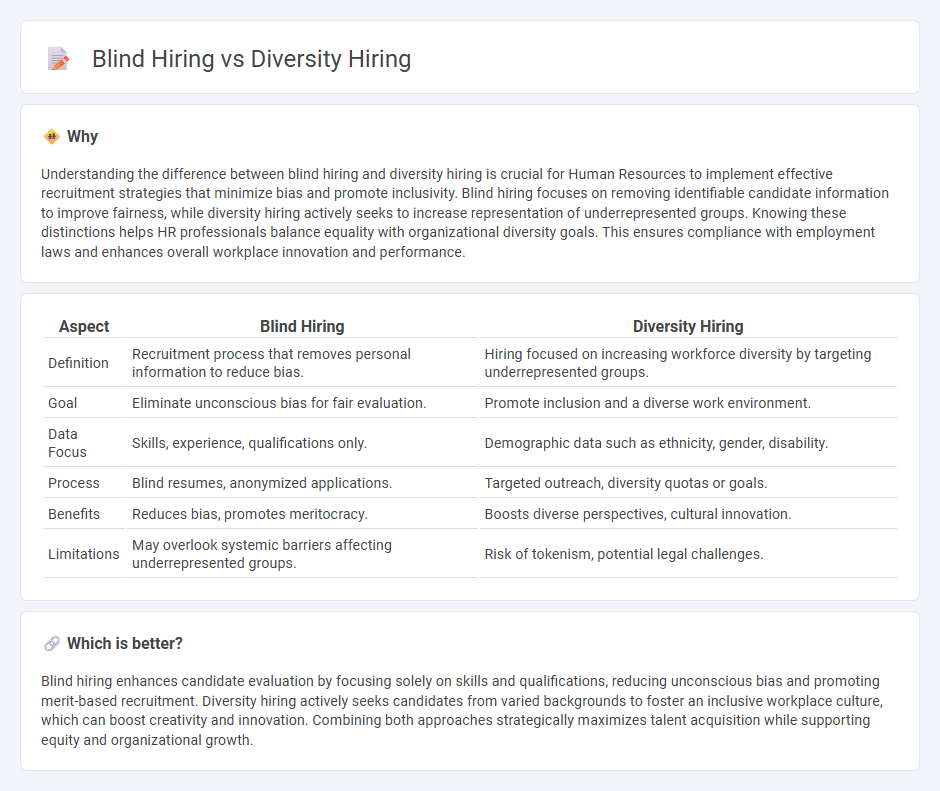
Blind hiring focuses on removing personal information such as names, gender, and age from resumes to reduce unconscious bias and promote merit-based recruitment. Diversity hiring aims to build a workforce that reflects various backgrounds, cultures, and perspectives to enhance creativity and organizational performance. Explore how integrating blind hiring and diversity hiring strategies can transform your talent acquisition process.
Why it is important
Understanding the difference between blind hiring and diversity hiring is crucial for Human Resources to implement effective recruitment strategies that minimize bias and promote inclusivity. Blind hiring focuses on removing identifiable candidate information to improve fairness, while diversity hiring actively seeks to increase representation of underrepresented groups. Knowing these distinctions helps HR professionals balance equality with organizational diversity goals. This ensures compliance with employment laws and enhances overall workplace innovation and performance.
Comparison Table
| Aspect | Blind Hiring | Diversity Hiring |
|---|---|---|
| Definition | Recruitment process that removes personal information to reduce bias. | Hiring focused on increasing workforce diversity by targeting underrepresented groups. |
| Goal | Eliminate unconscious bias for fair evaluation. | Promote inclusion and a diverse work environment. |
| Data Focus | Skills, experience, qualifications only. | Demographic data such as ethnicity, gender, disability. |
| Process | Blind resumes, anonymized applications. | Targeted outreach, diversity quotas or goals. |
| Benefits | Reduces bias, promotes meritocracy. | Boosts diverse perspectives, cultural innovation. |
| Limitations | May overlook systemic barriers affecting underrepresented groups. | Risk of tokenism, potential legal challenges. |
Which is better?
Blind hiring enhances candidate evaluation by focusing solely on skills and qualifications, reducing unconscious bias and promoting merit-based recruitment. Diversity hiring actively seeks candidates from varied backgrounds to foster an inclusive workplace culture, which can boost creativity and innovation. Combining both approaches strategically maximizes talent acquisition while supporting equity and organizational growth.
Connection
Blind hiring removes personal information such as names, gender, and ethnicity from job applications to reduce unconscious bias and promote fairness in the recruitment process. Diversity hiring focuses on actively sourcing and recruiting candidates from varied backgrounds to create inclusive work environments. Together, they enhance organizational diversity by ensuring equitable candidate evaluation and expanding talent pools across underrepresented groups.
Key Terms
**Diversity Hiring:**
Diversity hiring targets creating a more inclusive workforce by actively seeking candidates from underrepresented groups, enhancing innovation and company culture through varied perspectives. This approach involves structured outreach, bias training, and equitable evaluation criteria to ensure fair representation across gender, ethnicity, age, and other dimensions. Discover how diversity hiring strategies can transform organizational success and promote social equity.
Inclusion
Diversity hiring prioritizes recruiting candidates from varied backgrounds to foster an inclusive workplace that reflects multiple perspectives. Blind hiring removes identifiable information from applications to minimize unconscious bias and ensure fair evaluation based solely on skills and qualifications. Explore effective strategies to balance diversity and inclusion through innovative hiring practices.
Representation
Diversity hiring emphasizes achieving equitable representation of underrepresented groups to foster inclusion and innovation within organizations. Blind hiring removes demographic information from applications to reduce unconscious bias, aiming for a fair evaluation based solely on skills and qualifications. Explore how each approach impacts workforce diversity and organizational culture by learning more about their strategies and outcomes.
Source and External Links
11 Diversity Recruiting Strategies to Upgrade Inclusive Hiring - Oleeo - Key strategies for diversity hiring include creating inclusive job descriptions, reaching diverse candidate pools, implementing blind recruitment, and establishing diverse hiring teams with clear diversity metrics to track progress and accountability.
Diversity hiring 101: A quintessential guide for recruiters - Recruit CRM - The diversity hiring process involves reviewing current recruitment for bias, focusing on achievable diversity goals, and changing candidate sourcing strategies to include inclusive job descriptions and broader outreach.
Benefits of Diversity Hiring & How to Do It - Revelo - Diversity hiring improves candidate experience, cultural matching, and innovation by using bias-mitigation techniques such as blind resumes and diverse interview panels, emphasizing skills over traditional markers to foster fairness and inclusion.
 dowidth.com
dowidth.com